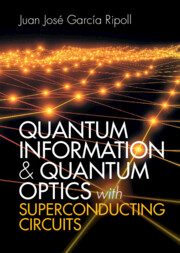Refine listing
Actions for selected content:
9096 results in Communications, Signal Processing and Information Theory
1 - Introduction
-
- Book:
- Quantum Information and Quantum Optics with Superconducting Circuits
- Published online:
- 04 August 2022
- Print publication:
- 18 August 2022, pp 1-6
-
- Chapter
- Export citation
4 - Regularization
- from Part I - Foundations
-
- Book:
- The Science of Deep Learning
- Published online:
- 23 September 2022
- Print publication:
- 18 August 2022, pp 56-66
-
- Chapter
- Export citation
2 - Quantum Mechanics
-
- Book:
- Quantum Information and Quantum Optics with Superconducting Circuits
- Published online:
- 04 August 2022
- Print publication:
- 18 August 2022, pp 7-18
-
- Chapter
- Export citation

Quantum Information and Quantum Optics with Superconducting Circuits
-
- Published online:
- 04 August 2022
- Print publication:
- 18 August 2022
15 - Over-the-Air Computation for Distributed Learning over Wireless Networks
- from Part II - Wireless Networks for Machine Learning
-
- Book:
- Machine Learning and Wireless Communications
- Published online:
- 16 June 2022
- Print publication:
- 04 August 2022, pp 434-456
-
- Chapter
- Export citation
7 - Constrained Unsupervised Learning for Wireless Network Optimization
- from Part I - Machine Learning for Wireless Networks
-
- Book:
- Machine Learning and Wireless Communications
- Published online:
- 16 June 2022
- Print publication:
- 04 August 2022, pp 182-211
-
- Chapter
- Export citation
16 - Federated Knowledge Distillation
- from Part II - Wireless Networks for Machine Learning
-
- Book:
- Machine Learning and Wireless Communications
- Published online:
- 16 June 2022
- Print publication:
- 04 August 2022, pp 457-485
-
- Chapter
- Export citation
11 - Capacity Estimation Using Machine Learning
- from Part I - Machine Learning for Wireless Networks
-
- Book:
- Machine Learning and Wireless Communications
- Published online:
- 16 June 2022
- Print publication:
- 04 August 2022, pp 317-350
-
- Chapter
- Export citation
9 - Reinforcement Learning for Physical Layer Communications
- from Part I - Machine Learning for Wireless Networks
-
- Book:
- Machine Learning and Wireless Communications
- Published online:
- 16 June 2022
- Print publication:
- 04 August 2022, pp 231-284
-
- Chapter
- Export citation
2 - Deep Neural Networks for Joint Source-Channel Coding
- from Part I - Machine Learning for Wireless Networks
-
- Book:
- Machine Learning and Wireless Communications
- Published online:
- 16 June 2022
- Print publication:
- 04 August 2022, pp 23-54
-
- Chapter
- Export citation
12 - Collaborative Learning over Wireless Networks: An Introductory Overview
- from Part II - Wireless Networks for Machine Learning
-
- Book:
- Machine Learning and Wireless Communications
- Published online:
- 16 June 2022
- Print publication:
- 04 August 2022, pp 353-384
-
- Chapter
- Export citation
6 - Model-Based Machine Learning for Communications
- from Part I - Machine Learning for Wireless Networks
-
- Book:
- Machine Learning and Wireless Communications
- Published online:
- 16 June 2022
- Print publication:
- 04 August 2022, pp 145-181
-
- Chapter
- Export citation
4 - Channel Coding via Machine Learning
- from Part I - Machine Learning for Wireless Networks
-
- Book:
- Machine Learning and Wireless Communications
- Published online:
- 16 June 2022
- Print publication:
- 04 August 2022, pp 77-109
-
- Chapter
- Export citation
5 - Channel Estimation, Feedback, and Signal Detection
- from Part I - Machine Learning for Wireless Networks
-
- Book:
- Machine Learning and Wireless Communications
- Published online:
- 16 June 2022
- Print publication:
- 04 August 2022, pp 110-144
-
- Chapter
- Export citation
Dedication
-
- Book:
- Machine Learning and Wireless Communications
- Published online:
- 16 June 2022
- Print publication:
- 04 August 2022, pp v-vi
-
- Chapter
- Export citation
8 - Radio Resource Allocation in Smart Radio Environments
- from Part I - Machine Learning for Wireless Networks
-
- Book:
- Machine Learning and Wireless Communications
- Published online:
- 16 June 2022
- Print publication:
- 04 August 2022, pp 212-230
-
- Chapter
- Export citation
Part II - Wireless Networks for Machine Learning
-
- Book:
- Machine Learning and Wireless Communications
- Published online:
- 16 June 2022
- Print publication:
- 04 August 2022, pp 351-352
-
- Chapter
- Export citation
18 - Timely Wireless Edge Inference
- from Part II - Wireless Networks for Machine Learning
-
- Book:
- Machine Learning and Wireless Communications
- Published online:
- 16 June 2022
- Print publication:
- 04 August 2022, pp 512-538
-
- Chapter
- Export citation
Index
-
- Book:
- Machine Learning and Wireless Communications
- Published online:
- 16 June 2022
- Print publication:
- 04 August 2022, pp 539-544
-
- Chapter
- Export citation
13 - Optimized Federated Learning in Wireless Networks with Constrained Resources
- from Part II - Wireless Networks for Machine Learning
-
- Book:
- Machine Learning and Wireless Communications
- Published online:
- 16 June 2022
- Print publication:
- 04 August 2022, pp 385-408
-
- Chapter
- Export citation
